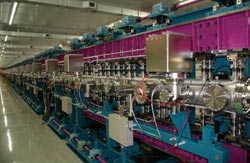Intense 2-color double X-ray laser pulses: a powerful tool to study ultrafast processes

A team working at the SACLA X-ray Free-Electron Laser in Japan has succeeded in generating ultra-bright, two-color X-ray laser pulses, for the first time in the hard X-ray region. These light pulses with different wavelengths, whose time separation can be adjusted with attosecond accuracy, are very powerful tools to investigate the structure of matter and the dynamics of ultrafast physical processes and chemical reactions.<br><br>Credit: RIKEN<br>
These light pulses with different wavelengths, whose time separation can be adjusted with attosecond accuracy, are very powerful tools to investigate the structure of matter and the dynamics of ultrafast physical processes and chemical reactions.
SACLA is one of only two facilities in the world to offer XFEL as light source to investigate matter, with various applications in biology, chemistry, physics and materials science. XFELs have the capacity to deliver radiation ten billion times brighter and with pulses one thousand times shorter than existing synchrotron X-ray radiation sources. Until now, XFELs have normally emitted one radiation pulse at a single wavelength like conventional visible lasers.
The Japanese team led by Toru Hara of the RIKEN SPring-8 Center, reports today in the journal Nature Communications that they have succeeded in creating double X-ray pulses with tunable wavelengths that can be relatively separated by more than 30%. This was achieved using variable-gap undulators, that act as a radiator and whose resonant wavelength can be largely varied by changing the magnetic field strength.
“The relative separation we have achieved is ten times bigger than what had been achieved in the past, and will make two-color lasers much easier to use as a light source. In addition, the two-color pulses can be emitted on different axes to spatially separate them. Our achievement significantly ameliorates the usability of XFEL,” explains Dr Hara.
The laser pulses, that last for less than 10 femtoseconds (10−15 s) and have peak powers of a few giga-watts, can be generated with time intervals adjusted with attosecond (10-16 s) precision.
“This will enable us to elucidate X-ray-induced ultrafast transitions of electronic states and structures, which will significantly contribute to the advancement of ultrafast chemistry, plasma physics and astrophysics, and X-ray quantum optics,” conclude the authors.
For more information please contact:
Juliette Savin
Global Relations Office
RIKEN
Tel: +81-(0)48-462-1225
email: pr@riken.jp
Reference:
Hara et al. “Two-colour hard X-ray free-electron laser with wide tunability”
Nature Communications, 2013
About RIKEN
RIKEN is Japan's largest research institute for basic and applied research. Over 2500 papers by RIKEN researchers are published every year in leading scientific and technology journals covering a broad spectrum of disciplines including physics, chemistry, biology, engineering, and medical science. RIKEN's research environment and strong emphasis on interdisciplinary collaboration and globalization has earned a worldwide reputation for scientific excellence.
About the SPring-8 Center
The RIKEN SPring-8 Center (RSC) was established in 2005 as a photon science research complex to enhance the distinctive capabilities of X-ray science. RSC is now the only research entity in the world offering both an X-ray free electron laser (SACLA) and a Synchrotron Radiation facility (SPring-8), at the same location.
About SACLA
In 2012, with the opening of SACLA, RIKEN became the second institution in the world to offer X-ray Free Electron Laser (XFEL) for research. The facility boasts the shortest wavelength in the world (0.6 nm), an extremely broad wavelength range and a very high peak output of 100 GW. This unique X-ray laser enables researchers to peer deeper inside matter and investigate unexplored areas of research.
Media Contact
More Information:
http://www.riken.jpAll latest news from the category: Process Engineering
This special field revolves around processes for modifying material properties (milling, cooling), composition (filtration, distillation) and type (oxidation, hydration).
Valuable information is available on a broad range of technologies including material separation, laser processes, measuring techniques and robot engineering in addition to testing methods and coating and materials analysis processes.
Newest articles

Properties of new materials for microchips
… can now be measured well. Reseachers of Delft University of Technology demonstrated measuring performance properties of ultrathin silicon membranes. Making ever smaller and more powerful chips requires new ultrathin…

Floating solar’s potential
… to support sustainable development by addressing climate, water, and energy goals holistically. A new study published this week in Nature Energy raises the potential for floating solar photovoltaics (FPV)…

Skyrmions move at record speeds
… a step towards the computing of the future. An international research team led by scientists from the CNRS1 has discovered that the magnetic nanobubbles2 known as skyrmions can be…





















